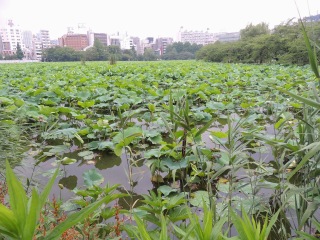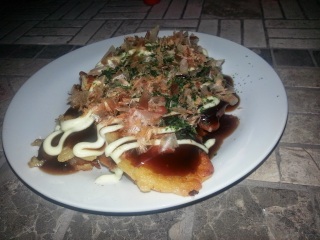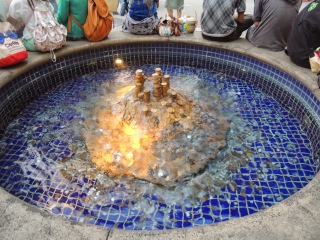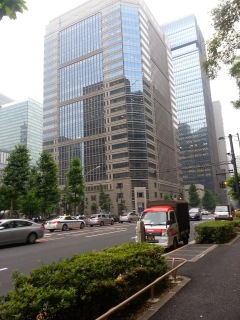One of my longest days, Day 21 started with a field trip with my Professor and the rest of the class to Tsukiji fish market, the world’s largest seafood wholesale market. As I got out of the train at Tsukiji station, I saw a man with a box of fish walk past me.
Tsukiji, established around 1923, starts operations around 3 am every night when fish and other seafood is brought in to be auctioned and sold. Some of the fish is freshly caught from the sea whereas others are imported. The fish available is extremely high quality. As we walked around the market, I noticed that the prices were unusually high for wholesale. The market was not just selling fish. It also included fruits, vegetables and other kinds of meat. Since many wholesalers come to Tsukiji market for fish, sellers of other items find it beneficial to set up their stores nearby. On the outer part of the market, there were people selling items such as chopsticks, knives, etc that restuarant owners may want for their restaurant. And ofcourse, there were several restaurants-sushi as well as other kinds of food. From what I understand, the Tsukiji market operations includes a vast variety of people in the distribution channel (wholesalers, producers, distributors, etc)
The fish (especially tuna, which is one of the more popular items) is auctioned around 5 a.m. By 9 a.m., most of the operations are over and cleaning begins. We took the tour around 9:30 a.m., and we saw several shop owners packing up for the day. Tsukiji market will soon be moved to another location and we were very lucky to see it in its original historic location.
Instead of smelling strong and repulsive as meat markets often do, Tsukiji market smelt quite fresh. We were given a tour by one of our Professors’ connections who owned a sushi restaurant nearby. As he took us around and introduced us to people he often deals with in the market, we were offered free samples and gifts. We got some delicious matcha tea (which if awfully generous considering how steeply priced matcha tea usually is), fresh fruit and squid.
 |
| The outer market of Tsukiji-which sells everything from meat, fruit, vegetables to cutlery, tea, etc |
 |
| A shop selling knives which are used to cut raw fish |
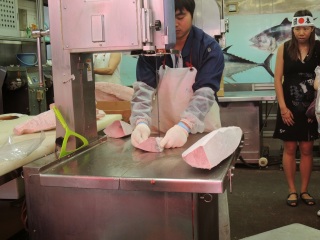 |
| Raw tuna being cut using this machine which has a blade running up and down (its almost too thin to be easily seen in this picture) |
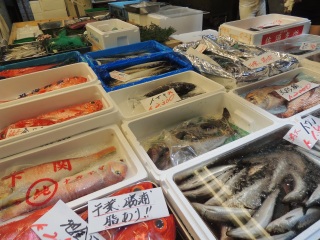 |
| Fresh fish being sold in the inner market-some of it is kept alive as long as possible so that its fresh when eaten. |
 |
| The inner market of Tsukiji-at 10 a.m. the shop keepers are cleaning up and ready to close |
 |
| Raw squid, one of the many samples we were offered. |
 |
| The first ever Yoshinoya-a famous chain which gave its name to the concept of Japanese fast food restaurants |
 |
| Machines used to transport tuna every morning. Since the tuna for the day had already been transported, we hopped on and got to take a quick round on it! |
 |
| At a shrine in Tsukiji. The restaurant owner (man in the picture) who was showing us around told us that there is a specific way to go through this circle. You put your left left first through the circle, then go towards the left and return to the center,. Again putting your left left through the circle first, you go towards the right side, making an eight and then go into the shrine. |
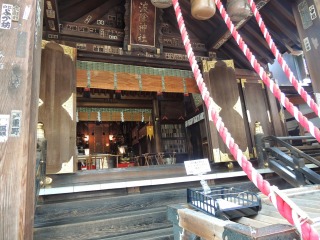 |
| Three strings leading up to bells on top. Like in Hindu temples, these bells are used to get the attention of the Shinto Gods. |
After the tour of Tsukiji market, we went to the restaurant owners’ restaurant for lunch. It was all you can eat sushi. We also got some sake along with other snacks such as fried chicken, egg pastries and some sea food fritters (I’m not sure what their actual names are). This restaurant, called Tama Sushi, was established in 1924 and the current owner was the fourth generation member of his family to run the place. The restaurant was very cute and we sat in a long room with low tables and chairs. The sushi was very fresh and well made, literally the best I’d ever had. Though this was only the fourth or fifth time I was eating sushi in my life, I knew that such standards are hard to meet and based on my more experienced classmates reaction, this really was amazing sushi. Tama sushi was the restaurant which invented Temaki, the hand roll sometime in the 1970s. Temaki is a very popular food item which is now available across almost every convenience store in Japan.
 |
| Yummy sushi |
After we were done eating, everyone got the chance to make sushi themselves. Two people would go up to a cooking counter at the end of the room and two expert chefs would teach them how to make sushi. Four people would sit on the other side of the counter and eat the sushi made. When my turn came, I found that making sushi is harder than it looks. You first dip your hand in water so that the sticky rice doesn’t stick to your hands. Then you take some rice in your hand and roll it. The cut slice of raw fish with some wasabi on it is then put over the rice and the rice is pushed inwards so that its in line with the raw fish. The height or width of the rice has to be exactly right for the sushi to stand.
 |
| Sushi making with the chefs. |
 |
| Getting ready to make sushi! We were dressed in a white jacket, a wrap around white skirt and the white paper hat before we started. |
After the amazing experience at the restaurant we went to Tokyo tower, which is a broadcasting tower, also open to tourists for viewing from the top floor. The Tokyo tower looks much like a big telephone tower and is the second tallest structure in Japan after the Tokyo skytree. A new thing I learnt while I was there was that the Tokyo tower is very earthquake resistant (probably more so than regular houses).
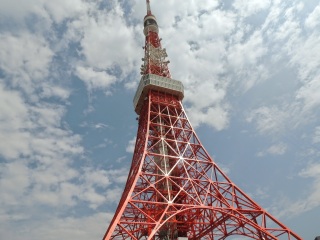 |
| Tokyo Tower |
 |
| A view of Tokyo from the observatory of Tokyo Tower |
 |
| A robot in the observatory which gives tours and explanations to people. Currently, it is moving towards it charging portal. It has screens on the side which say so. It talks too! The robot is able to detect people and makes sure it doesn’t crash into visitors. |
We got the chance to meet up with a Yale graduate working in Tokyo Tower, who told us about the work culture in Japan among other things. I was surprised to learn that Japanese students get a fairly generalized education which is not vocational (like it is in other Asian countries where people want to go for engineering, medicine, law). So when Japanese companies hire foreigners, they are often more inclined to hire people with specific skill sets. Another new piece of information for me was that Japanese companies take care of their employees well and often have a family like atmosphere. Working long hours and being a committed to the company for a significant period of time (often their whole working life) earns them close relationships with colleagues and seniors. On talking to my host parents, I was told that Japanese students don’t choose their majors with the job scene in mind. They study what they’re interested in and don’t have as much pressure from their families as students often do in other Asian countries. I was reminded that Japan is a developed Asian country which sets it apart from the bulk of developing Asian countries. Economic security and the promise of having a decent job after graduation affects the culture and lifestyle of Japan and that makes me think that maybe other Asian countries will follow suit as they develop.
The Yale graduate also showed us this big circular room with three large screens. The room was all white. It is used for public viewings and events such as football matches, weddings, etc. It was interesting to hear the kind of purposes the room served. Creating such space in an acclaimed place like Tokyo tower is a genius commercialization move.
 |
| A blurred picture of dessert at Tokyo tower-waffle with green tea ice cream, whipped cream and red bean. I also got the chance to have a matcha latte topped with a bit of ice cream. |
Our official field trip ended here and we went to Ginza for Karoake after that. The prices of Karoake places in Ginza was very high, not just because Ginza is one of the most upscale neighborhoods of Tokyo, but also because this was a Friday night. Finally we found a cheap and sort of shady place. Over some drinks (karoake places require atleast one drink per person to be ordered),the six of us spent the next two hours in a cozy room singing Hollywood music. I once again ordered Umeshu, the Japanese plum wine. This was my first time doing Karoake. It was so fun. Some of the technology in a low end place like this was pleasantly surprising. There was an intercom telephone in the karaoke room and there were devices using which we could select the songs we wanted. At first we weren’t sure if they’d even have english music available, but it had quite a large variety of songs.
 |
| Ending Friday with Karoake! |
Having been up and about for 18 hours, I was tired by the time I got home but at the same time very satisfied with all my new experiences.





